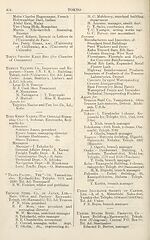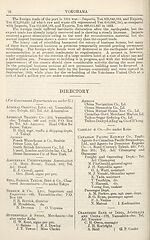1926
(527) Page 475 - Yokohama
Download files
Complete book:
Individual page:
Thumbnail gallery: Grid view | List view

TOKYO—YOKOHAMA
475.
Vacuum Oil Co. of New York -Tokio
Kaijo Building, 1, Yeiraku-cho, Itchome,
Kojimachi-ku; Tel. Ad: Vacuum
E. G. Sandler, manager
C. E. Fox
Yorkshire Insurance Co., Lid.—Kata-
kura Building, 8, Tatami-cho, Kyoba-
shi-ku; Teleph. 1552 (Ginza); Til. Ad:
Yorkshire; Code: Bentley’s
F. D. Charles, manager
C. R. Agar
YOKOHAMA
Yokohama is the port of Tokyo and was opened to foreign trade in July, 1859,.
It is situated on the Bay of Yokohama, a small bay on the western side of the Gulf of
Yedo, in lat. 35 deg. 26 min. 11 sec. N., and long. 139 deg. 39 min. 20 sec., in the island
of Honshiu, and is distant about 18 miles from the capital, with which it is connected
by both steam and electric railways. The surrounding scenery is hilly and pleasing,
and on clear days the snow-crowned summit and graceful outlines of Fuji-san, a
volcanic mountain 12,370 feet high—celebrated in Japanese literature and depicted on
innumerable native works of art—is most distinctly visible, though some 75 miles-
distant. The town is divided into two parts, the western part being occupied by
what was known, before the abolition of extra-territoriality, as the foreign settlement.
Beyond the plain on which the town is built rises a sort of semi-circle of low hills called
“The Bluff, thickly dotted before the recent terrible visitation with handsome foreign
villas and dwelling-houses in various styles of architecture, all standing in pretty
gardens and commanding charming prospects. Along the water-front runs a good
road called the Bund, on which stood many of the principal business houses and
hotels. The United Club was located here. The English Episcopal, the French Catholic
and the Union Protestant Churches were handsome edifices situated on the Bluff, where
there were also well laid-out public gardens. A fine cricket and recreation ground, a
racecourse and golf links are situated about two miles from the Settlement. A good
boating club also existed, providing facilities for deep-sea bathing. The Public Hall,,
containing a theatre and assembly rooms, built of brick, situated at the top of Camp
Hill, was opened in 1885. The Prefectural and Municipal Offices were fine brick
structures on commanding sites. The railway station was well-designed and com¬
modious. The town is in tne enjoyment of an excellent water supply, large waterworks
having been completed in 1887. An electric train service from Yokohama (Sakuragi-
cho) to Tokyo (new station) runs every twelve minutes, covering the distance in 55
minutes. The harbour is exposed, but two breakwaters, of an aggregate length of
12,000 feet, have been built and are so projected as practically to enclose the whole of
the anchorage, leaving an entrance 650 feet wide between these extremities. Excellent
pier and wharf facilities exist, and, though practically entirely destroyed in the
earthquake and fire of 1923, they are now all restored. There are 4 berths at the pier
accommodating the largest steamers, and 12 mooring wharves for large ocean-going
vessels, most of these wharves accommodating vessels of any size. The Yokohama
Dock Company has three dry docks of 631 ft., 489 ft., and 380 ft., docking length, 93 ft.,
67 ft., and 60 ft. width of entrance, and 28 ft., 21.5 ft. and 26 ft. of water on the blocks,
respectively, and a mooring basin of 600 ft. by 100 ft. by 25 ft.
In the very severe earthquake, which was followed by a huge conflagration, on
September 1st, 1923, close on 30,000 people ai’e known to have perished. Another 3,550
were missing and believed to be dead, and 66,371 were officially reported as injured, the
total casualties representing nearly one-quarter of the population. The number of
buildings destroyed was 70,000, out of a total of 93,000. The shipping in harbour was
placed in serious jeopardy by the blazing oil from the oil-tanks on shore running into
and spreading over the water.
The Japanese population of Yokohama was about 422,942 in 1920, according to the
Census returns of that year. It is computed that it is now about 380,000. There
was a great exodus as the result of the earthquake, but confidence is now restored and
there seems every reason to expect that in time Yokohama will recover its former pro¬
minence as the principal port of Japan.
475.
Vacuum Oil Co. of New York -Tokio
Kaijo Building, 1, Yeiraku-cho, Itchome,
Kojimachi-ku; Tel. Ad: Vacuum
E. G. Sandler, manager
C. E. Fox
Yorkshire Insurance Co., Lid.—Kata-
kura Building, 8, Tatami-cho, Kyoba-
shi-ku; Teleph. 1552 (Ginza); Til. Ad:
Yorkshire; Code: Bentley’s
F. D. Charles, manager
C. R. Agar
YOKOHAMA
Yokohama is the port of Tokyo and was opened to foreign trade in July, 1859,.
It is situated on the Bay of Yokohama, a small bay on the western side of the Gulf of
Yedo, in lat. 35 deg. 26 min. 11 sec. N., and long. 139 deg. 39 min. 20 sec., in the island
of Honshiu, and is distant about 18 miles from the capital, with which it is connected
by both steam and electric railways. The surrounding scenery is hilly and pleasing,
and on clear days the snow-crowned summit and graceful outlines of Fuji-san, a
volcanic mountain 12,370 feet high—celebrated in Japanese literature and depicted on
innumerable native works of art—is most distinctly visible, though some 75 miles-
distant. The town is divided into two parts, the western part being occupied by
what was known, before the abolition of extra-territoriality, as the foreign settlement.
Beyond the plain on which the town is built rises a sort of semi-circle of low hills called
“The Bluff, thickly dotted before the recent terrible visitation with handsome foreign
villas and dwelling-houses in various styles of architecture, all standing in pretty
gardens and commanding charming prospects. Along the water-front runs a good
road called the Bund, on which stood many of the principal business houses and
hotels. The United Club was located here. The English Episcopal, the French Catholic
and the Union Protestant Churches were handsome edifices situated on the Bluff, where
there were also well laid-out public gardens. A fine cricket and recreation ground, a
racecourse and golf links are situated about two miles from the Settlement. A good
boating club also existed, providing facilities for deep-sea bathing. The Public Hall,,
containing a theatre and assembly rooms, built of brick, situated at the top of Camp
Hill, was opened in 1885. The Prefectural and Municipal Offices were fine brick
structures on commanding sites. The railway station was well-designed and com¬
modious. The town is in tne enjoyment of an excellent water supply, large waterworks
having been completed in 1887. An electric train service from Yokohama (Sakuragi-
cho) to Tokyo (new station) runs every twelve minutes, covering the distance in 55
minutes. The harbour is exposed, but two breakwaters, of an aggregate length of
12,000 feet, have been built and are so projected as practically to enclose the whole of
the anchorage, leaving an entrance 650 feet wide between these extremities. Excellent
pier and wharf facilities exist, and, though practically entirely destroyed in the
earthquake and fire of 1923, they are now all restored. There are 4 berths at the pier
accommodating the largest steamers, and 12 mooring wharves for large ocean-going
vessels, most of these wharves accommodating vessels of any size. The Yokohama
Dock Company has three dry docks of 631 ft., 489 ft., and 380 ft., docking length, 93 ft.,
67 ft., and 60 ft. width of entrance, and 28 ft., 21.5 ft. and 26 ft. of water on the blocks,
respectively, and a mooring basin of 600 ft. by 100 ft. by 25 ft.
In the very severe earthquake, which was followed by a huge conflagration, on
September 1st, 1923, close on 30,000 people ai’e known to have perished. Another 3,550
were missing and believed to be dead, and 66,371 were officially reported as injured, the
total casualties representing nearly one-quarter of the population. The number of
buildings destroyed was 70,000, out of a total of 93,000. The shipping in harbour was
placed in serious jeopardy by the blazing oil from the oil-tanks on shore running into
and spreading over the water.
The Japanese population of Yokohama was about 422,942 in 1920, according to the
Census returns of that year. It is computed that it is now about 380,000. There
was a great exodus as the result of the earthquake, but confidence is now restored and
there seems every reason to expect that in time Yokohama will recover its former pro¬
minence as the principal port of Japan.
Set display mode to:
![]() Universal Viewer |
Universal Viewer | ![]() Mirador |
Large image | Transcription
Mirador |
Large image | Transcription
Images and transcriptions on this page, including medium image downloads, may be used under the Creative Commons Attribution 4.0 International Licence unless otherwise stated. ![]()
| Asian directories and chronicles > 1926 > (527) Page 475 - Yokohama |
|---|
| Permanent URL | https://digital.nls.uk/196495024 |
|---|
| Attribution and copyright: |
|
|---|---|
| Description | Volumes from the Asian 'Directory and Chronicle' series covering 1917-1941, but missing 1919 and 1923. Compiled annually from a multiplicity of local sources and research. They provide listings of each country's active corporations, foreign residents and government agencies of all nationalities for that year, together with their addresses. Content includes: various treaties; coverage of conflicts; currencies and taxes; consular fees; weights and measures; public holidays; festivals and traditions. A source of information for both Western states and communities of foreigners living in Asia. Published by Hongkong Daily Press. |
|---|---|
| Shelfmark | H3.86.1303 |
| Additional NLS resources: |

